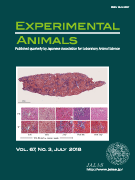67 巻, 3 号
選択された号の論文の12件中1~12を表示しています
- |<
- <
- 1
- >
- >|
Review
-
2018 年 67 巻 3 号 p. 301-312
発行日: 2018年
公開日: 2018/07/30
[早期公開] 公開日: 2018/02/08PDF形式でダウンロード (1148K)
Original
-
2018 年 67 巻 3 号 p. 313-320
発行日: 2018年
公開日: 2018/07/30
[早期公開] 公開日: 2018/02/02PDF形式でダウンロード (1360K) -
2018 年 67 巻 3 号 p. 321-327
発行日: 2018年
公開日: 2018/07/30
[早期公開] 公開日: 2018/02/22PDF形式でダウンロード (2269K) -
2018 年 67 巻 3 号 p. 329-336
発行日: 2018年
公開日: 2018/07/30
[早期公開] 公開日: 2018/02/14PDF形式でダウンロード (710K) -
2018 年 67 巻 3 号 p. 337-347
発行日: 2018年
公開日: 2018/07/30
[早期公開] 公開日: 2018/03/09PDF形式でダウンロード (3616K) -
2018 年 67 巻 3 号 p. 349-359
発行日: 2018年
公開日: 2018/07/30
[早期公開] 公開日: 2018/03/08PDF形式でダウンロード (1794K) -
2018 年 67 巻 3 号 p. 361-371
発行日: 2018年
公開日: 2018/07/30
[早期公開] 公開日: 2018/03/09PDF形式でダウンロード (8513K) -
2018 年 67 巻 3 号 p. 373-382
発行日: 2018年
公開日: 2018/07/30
[早期公開] 公開日: 2018/04/25PDF形式でダウンロード (2222K) -
2018 年 67 巻 3 号 p. 383-392
発行日: 2018年
公開日: 2018/07/30
[早期公開] 公開日: 2018/04/20PDF形式でダウンロード (2432K)
Retraction
-
2018 年 67 巻 3 号 p. R1-
発行日: 2018年
公開日: 2018/07/30
PDF形式でダウンロード (299K) -
2018 年 67 巻 3 号 p. R2-
発行日: 2018年
公開日: 2018/07/30
PDF形式でダウンロード (299K) -
2018 年 67 巻 3 号 p. R3-
発行日: 2018年
公開日: 2018/07/30
PDF形式でダウンロード (299K)
- |<
- <
- 1
- >
- >|
